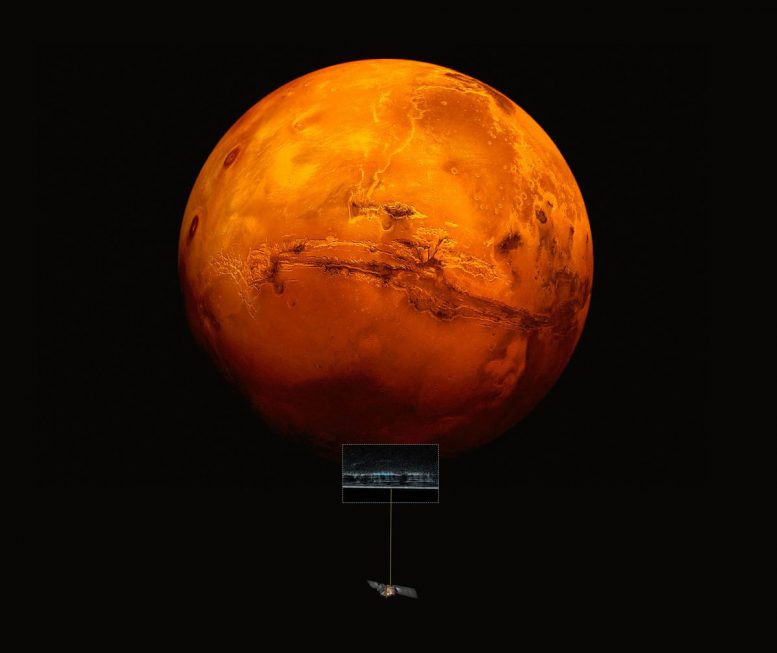
ARTISTIC IMPRESSION OF THE MARS EXPRESS SPACECRAFT PROBING THE SOUTHERN HEMISPHERE OF MARS. A RADAR CROSS SECTION OF THE SOUTHERN POLAR LAYERED DEPOSITS IS SHOWN AS A DETAIL. THE LIGHT BLUE SPOTS ALONG THE BASAL RADAR ECHO HIGHLIGHT AREAS OF VERY HIGH REFLECTIVITY, INTERPRETED AS BEING CAUSED BY THE PRESENCE OF WATER. | ESA, INAF. GRAPHIC RENDERING BY DAVIDE COERO BORGA
Using radar to probe the polar ice caps of Mars, scientists have detected an underground reservoir of liquid that may be saltwater and that extends for about 20 kilometers (12 miles) in length. The results, published July 25 in Science, provide some resolution to a decades-long debate over whether a sizable body of liquid water is present on Mars.
“Water is considered one of the fundamental requirements for life. This is the first stable body of liquid water ever found on Mars, and it could be considered a potential habitat,” explained Roberto Orosei, a lead scientist at the Institute of Radioastronomy in Italy who analyzed the data.
The Red Planet was likely once rich in liquid water much like Earth, but has since become arid and desolate. Traces of water have been found in its atmosphere and leeching through its soils, but efforts to locate bodies of water — a likely place to find life as we know it — have not yet been successful.
Between May 2012 and December 2015, the Mars Express spacecraft was used to conduct a radar survey of a region called Planum Australe, located in the southern ice cap of Mars. A tool onboard the spacecraft sends radar pulses that penetrate the surface and ice caps of the planet and reflections off subsurface features provide scientists with information about what lies below.
Over the course of the survey, Orosei and colleagues obtained 29 sets of radar samplings, mapping out an area exhibiting a very sharp change in its associated radar signal, just under a mile (about 1.5 kilometers) below the surface of the ice and extending laterally for about 12.4 miles (20 kilometers). The radar profile of this area is similar to that of lakes of liquid water found beneath the Antarctic and Greenland ice sheets on Earth, suggesting that there is a subglacial lake at this location on Mars.
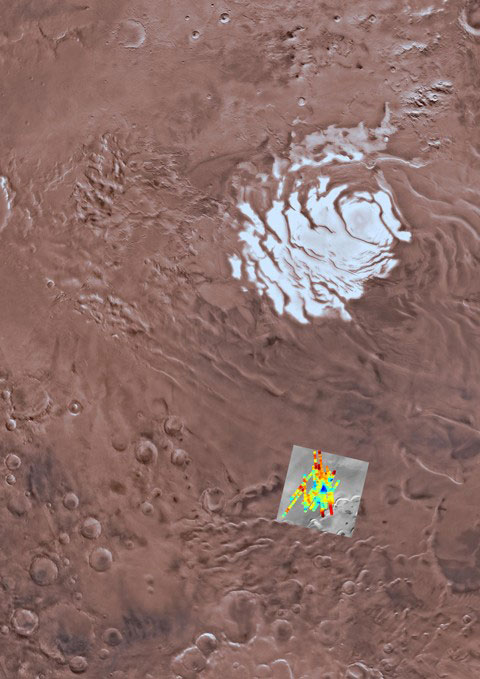
COLOR MOSAIC OF A PORTION OF PLANUM AUSTRALE. DEEP BLUE CORRESPONDS TO THE STRONGEST RADAR REFLECTIONS, WHICH ARE INTERPRETED AS BEING CAUSED BY THE PRESENCE OF WATER. | USGS ASTROGEOLOGY SCIENCE CENTER, ARIZONA STATE UNIVERSITY, INAF
“We found, in fact, that any other explanation for the very strong [radar] echoes was not very tenable in light of the evidence that we had available. So we had to conclude that there is water on Mars, today,” said Orosei.
Although the temperature of the lake is expected to be below the freezing point of pure water, the research team notes that salts of magnesium, calcium, and sodium — known to be present in Martian rocks — could be dissolved in the water to form a brine. Together with the pressure of the overlying ice, this would lower the melting point, allowing the lake to remain liquid as happens on Earth.
Orosei said that this subsurface body of water is at least as cold as 14° Fahrenheit (minus 10°Celsius, but could be as low as minus 76°F (minus 60°C). “This is certainly not a very pleasant environment for life … However, there are [analogous organisms] on Earth, in the subglacial lakes of Antarctica. There, water is salty and there are single-cell organisms that survive in such an environment, with a metabolism that makes use of the salts in the water,” he said.
Much more work needs to be done to confirm that the lake is liquid water, the researchers said, and there is no evidence yet that life exists in the lake. “Getting [to the reservoir] and acquiring the final evidence that this is indeed a lake will not be an easy task. It will require flying a robot there, which is capable of drilling through 1.5 kilometers of ice. And this will certainly require some technological developments that, at the moment, are not available,” Orosei said.
In the immediate future, Orosei said it will be important to keep acquiring raw data from the Martian poles, looking for more subglacial water.
“A single body of water could be a quirk of nature, but the existence of many lakes would indicate that subglacial water is a common occurrence, and that could mean that liquid water was present on Mars throughout most of its geological history,” he said. “This finding would have profound implications on the potential biological evolution of the planet.”
Reference: “Radar evidence of subglacial liquid water on Mars” by R. Orosei, S. E. Lauro, E. Pettinelli, A. Cicchetti, M. Coradini, B. Cosciotti, F. Di Paolo, E. Flamini, E. Mattei, M. Pajola, F. Soldovieri, M. Cartacci, F. Cassenti, A. Frigeri, S. Giuppi, R. Martufi, A. Masdea, G. Mitri, C. Nenna, R. Noschese, M. Restano, and R. Seu, 25 July 2018, Science.
DOI: 10.1126/science.aar7268


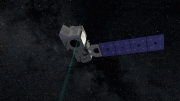

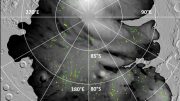
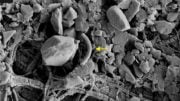
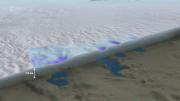
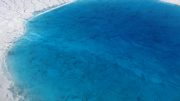

Be the first to comment on "Radar Probe Reveals Huge Reservoir of Liquid Water Under Mars’ Surface"